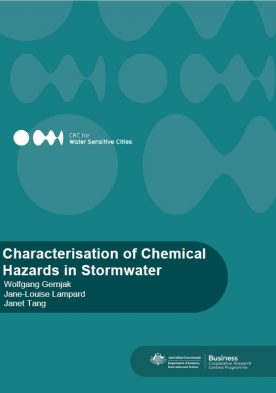Characterisation of chemical hazards in stormwater
Summary
The current report summarises the findings of a two phase investigation into the presence of chemicals in Australian stormwater (urban runoff). The data was produced within project C1.2 Cities as Water Supply Catchments – Risk and Health: Understanding Stormwater Quality Hazards within the scope of the CRC for Water Sensitive Cities. Water quality data presented are predominantly event mean concentrations from samples (n=94) collected during urban run-off events (2011-2014) from a total of ten different catchments across four states of Australia, i.e. New South Wales (n=21), Queensland (n=41), Victoria (n=26) and Western Australia (n=6, these samples were collected as grab samples during rain events).
This document follows the Urban Water Security Research Alliance Technical Report No. 102 Health Risk Assessment of Urban Stormwater (Sidhu et al 2012) which presented findings for phase one samples obtained during the preliminary scoping study for the project. Phase one samples were collected from eight catchments across New South Wales, Queensland and Victoria. An overview of these catchments can be found in Tang et al (2013). Samples were collected from an additional two sites in Western Australia during Phase Two. These sites consisted of an urban drain in the central area of Perth, and the inlet of the drainage system of a new urban development in the outer suburbs of Perth. The catchments in Queensland, New South Wales, Victoria and Western Australia are a combination of commercial, industrial, and residential land uses in temperate, sub-tropical and Mediterranean style climates. Samples were collected from within stormwater drains, from waters that receive stormwater, and from the inlets to wetland treatment systems in order to be representative of the broad range of capture locations that may be utilised for stormwater reuse schemes.
The study focused on several groups of contaminants, predominantly those present in the dissolved phase such as metals, nutrients, and hydrophilic trace organic contaminants such as pharmaceuticals, pesticides and endocrine-disrupting chemicals. Biological effects of the trace organic contaminants were measured by in vitro tests. Other bulk water quality properties, such as the presence of ions e.g. chloride and sulphate, electrical conductivity (EC), pH, total suspended solids (TSS), and ultraviolet absorbance were also measured. Phase one sampling investigated the presence of chemicals identified as potentially present in urban stormwater during a review of international, peer-reviewed and grey literature pertaining to the water quality characteristics of urban stormwater runoff. Analyses for phase two samples focused on those chemicals detected during phase one sampling. Methodological procedures for chemical and bioassay analyses conducted in this project are described in Sidhu et al. (2012) and Tang et al. (2013).
